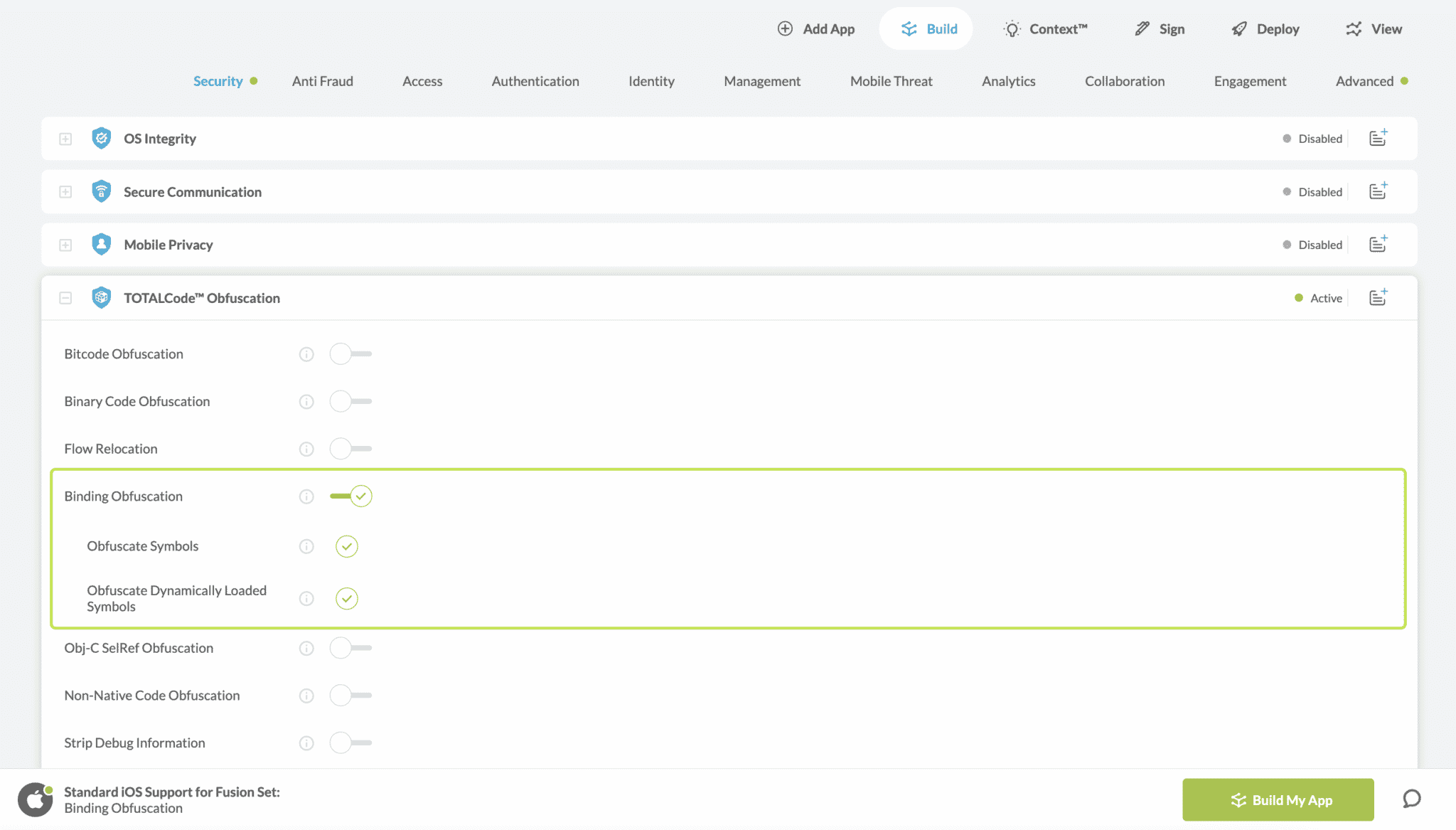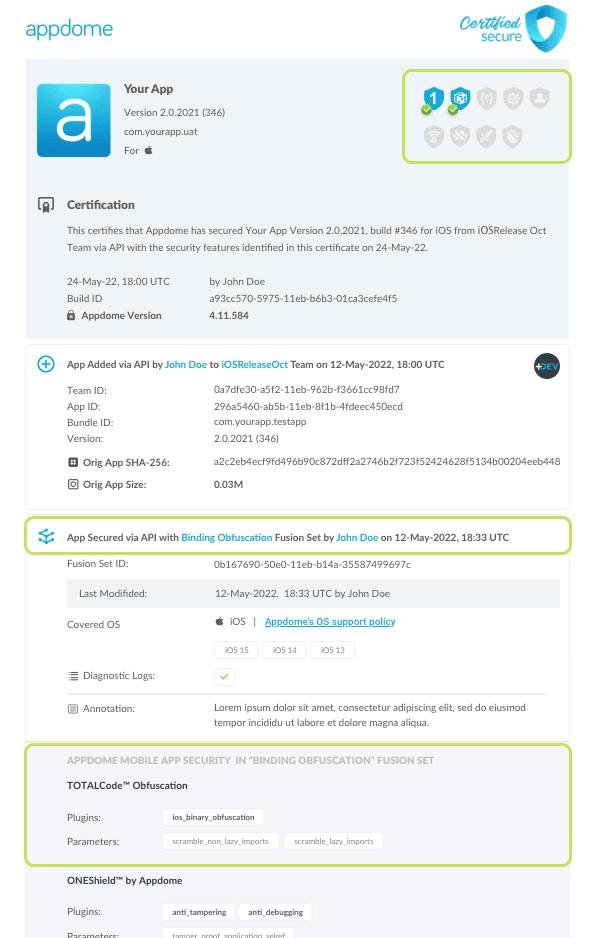iOS Binding Obfuscation, Anti-Reversing in iOS Apps
Learn to Add Binding Obfuscation in iOS apps, in mobile CI/CD with a Data-Driven DevSecOps™ build system.
What is Binding Obfuscation?
iOS apps consist of binaries in Mach-O format. This format contains “Binding Information” which is required to perform dynamic resolution of system symbols. “Binding Information” consists of a list of instructions the OS will follow when loading the app into memory so that the app has all it needs to function properly. One type of instruction will instruct OS to provide the app with the address of a function that is implemented in a system library, a.k.a dynamic resolution system symbols. Properly obfuscating binding information requires meeting both of the following conditions: (a) the binding instructions are rendered incomprehensible to an attacker, so they cannot be converted back to the original symbol while (b) when the app is launched, all required functions are resolved properly and in the correct timing.
Why Should Developers Obfuscate iOS Bindings?
Attackers will use Binding information during static analysis and reverse engineering to gain a deep understanding of the inner workings of an iOS app. The binding instructions list includes the system function names the app is planning to call. As a result, combining all of the system function names into a list provides an insight into the app’s business logic and potential vectors to attack the app. Furthermore, attackers can perform the opposite conversion, by following the binding instruction to convert the system function names to the location the OS is instructed to store the resolved address. In so doing they will find all calls to the system in question. Obfuscating iOS Bindings in the application binary will prevent the attackers from performing these conversions, thereby extremely reducing any risk of reverse engineering.
Prerequisites for Using Binding Obfuscation:
To use Appdome’s mobile app security build system to Add Binding Obfuscation , you’ll need:
- Appdome account (create a free Appdome account here)
- A license for Binding Obfuscation
- Mobile App (.ipa for iOS)
- Signing Credentials (see Signing Secure Android apps and Signing Secure iOS apps)
Add Binding Obfuscation on iOS apps using Appdome
On Appdome, follow these 3 simple steps to create self-defending iOS Apps that Add Binding Obfuscation without an SDK or gateway:
-
Upload the Mobile App to Appdome.
-
Upload an app to Appdome’s Mobile App Security Build System
-
Upload Method: Appdome Console or DEV-API
-
iOS Formats: .ipa
-
Binding Obfuscation Compatible With: Obj-C, C+, Java, Swift, Flutter, React Native, Unity, Xamarin, Cordova and more
-
-
Build the feature: Binding Obfuscation.
-
Building Binding Obfuscation by using Appdome’s DEV-API:
-
Create and name the Fusion Set (security template) that will contain the Binding Obfuscation feature as shown below:
-
Follow the steps in Sections 2.2.1-2.2.2 of this article, Building the Binding Obfuscation feature via Appdome Console, to add the Binding Obfuscation feature to this Fusion Set.
-
Open the Fusion Set Detail Summary by clicking the “...” symbol on the far-right corner of the Fusion Set, as shown in Figure 1 above, and get the Fusion Set ID from the Fusion Set Detail Summary (as shown below):

Figure 2: Fusion Set Detail Summary
Note: Annotating the Fusion Set to identify the protection(s) selected is optional only (not mandatory). -
Follow the instructions below to use the Fusion Set ID inside any standard mobile DevOps or CI/CD toolkit like Bitrise, App Center, Jenkins, Travis, Team City, Cirlce CI or other system:
-
Build an API for the app – for instructions, see the tasks under Appdome API Reference Guide
-
Look for sample APIs in Appdome’s GitHub Repository
-

Figure 1: Fusion Set that will contain the Binding Obfuscation feature
Note: Naming the Fusion Set to correspond to the protection(s) selected is for illustration purposes only (not required). -
-
Building the Binding Obfuscation feature via Appdome Console
To build the Binding Obfuscation protection by using Appdome Console, follow the instructions below.
-
Where: Inside the Appdome Console, go to Build > Security Tab > TOTALCode™ Obfuscation section.
-
When you select the Binding Obfuscation you'll notice that your Fusion Set you created in step 2.1.1 now bears the icon of the protection category that contains Binding Obfuscation

Figure 4: Fusion Set that displays the newly added Binding Obfuscation protection
-
Click Build My App at the bottom of the Build Workflow (shown in Figure 3).
-
Congratulations! The Binding Obfuscation protection is now added to the mobile app -
Using Appdome, there are no development or coding prerequisites to build secured iOS Apps by using Binding Obfuscation. There is no SDK and no library to code or implement in the app and no gateway to deploy in your network. All protections are built into each app and the resulting app is self-defending and self-protecting.
Releasing and Publishing Mobile Apps with Binding Obfuscation
After successfully securing your app by using Appdome, there are several available options to complete your project, depending on your app lifecycle or workflow. These include:
- Customizing, Configuring & Branding Secure Mobile Apps
- Deploying/Publishing Secure mobile apps to Public or Private app stores
- Releasing Secured Android & iOS Apps built on Appdome.
Related Articles:
- Dex Control Flow Relocation, Anti-Reversing for Android Apps
- How to Remove Debug Information, Anti-Reversing Android & iOS Apps
- Binary Code Obfuscation, Anti-Reversing – Android & iOS
If you have any questions, please send them our way at support.appdome.com or via the chat window on the Appdome platform.
Thank you!
Thanks for visiting Appdome! Our mission is to secure every app on the planet by making mobile app security easy. We hope we’re living up to the mission with your project.


